Archaeology and Cultural Resources
Archaeological sites, features, and artifacts are known within the field as cultural resources. In the Anza-Borrego Desert, Cuyamaca Rancho and Palomar State Parks, studying and recording information about cultural resources is an important archaeological responsibility. The Colorado Desert District has abundant pre-historic and historic cultural resources throughout all the parks.
When preserved in place, archaeological sites afford wonderful opportunities for visitors to visualize and learn about the people and activities that make up our collective prehistory and history.
Site Integrity
Prehistoric and historic archaeological resources – together with ethnography, oral history, and archival research – provide us with important information to research past life ways. Integrity of site deposits is essential for this study. Intact surface materials can provide information on the variety and organization of a people’s activities. Intact subsurface deposits can provide information on how and why these activities changed through time.
can provide information on the variety and organization of a people’s activities. Intact subsurface deposits can provide information on how and why these activities changed through time.
Site integrity is critical to the value of the cultural resources throughout the Colorado Desert State Parks. Trails, facilities, camping, or relic collecting damage the spatial organization of an archaeological site and the information value it contains is irreversibly damaged. When impacts threaten the integrity of a site or when relevant research issues require archaeological data, research-design-guided excavations ensure that artifacts and documentation will be preserved appropriately in a curation facility.
Education and Research Possibilities
Proper curation and display of materials requires a comprehensive catalog to document  provenience and provide controlled storage conditions. Opportunities for future study and display are possible when professional curation standards are used. Consultation with the peoples whose material remains are represented is an important and essential element of excavation and curation.
provenience and provide controlled storage conditions. Opportunities for future study and display are possible when professional curation standards are used. Consultation with the peoples whose material remains are represented is an important and essential element of excavation and curation.

